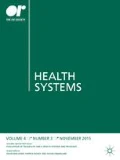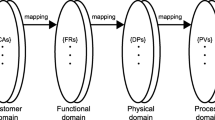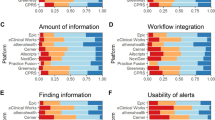Abstract
Support is considered an important factor for realizing the benefits of health information technology, but there is a dearth of research on the topic of support, especially in primary care. We conducted a qualitative multiple case study of four family health teams and one family health organization in Ontario, Canada in an attempt to gain insight into users’ expectations and needs, and the realities of end-user support for primary care electronic medical records. Data were collected by semi-structured interviews, document review, and observation of training sessions. The analysis highlights the important role of on-site information technology staff and super-users in liaising with various stakeholders to solve technical problems and providing hardware and functional (how to) support; the local development of data support practices to ensure consistent documentation; and the gaps that exist in users’ and support personnel’s understanding of each other’s work processes.
Similar content being viewed by others
References
Arts DG, DE Keizer NF and Scheffr GJ (2002) Defining and improving data quality in medical registries: a literature review, case study, and generic framework. Journal of the American Medical Informatics Association 9 (6), 600–611.
Ash J (1997) Organizational factors that influence information technology diffusion in academic health sciences centers. Journal of the American Medical Informatics Association 4 (2), 102–111.
Ash JS, Stavri PZ, Dykstra R and Fournier L (2003) Implementing computerized physician order entry: the importance of special people. International Journal of Medical Informatics 69 (2–3), 235–250.
Baum A et al (2004) Assessing the impact of change in the organization of a technical support system for a health information systems (HIS). Studies in Health Technology and Informatics 107 (Pt 2), 1367–1370.
Berglund E and Priestley M (2001) Open-source documentation: in search of user-driven, just-in-time writing. In Proceedings of the 19th Annual International Conference on Computer Documentation, pp 132–141, ACM, Sante Fe, New Mexico.
Blumenthal D and Tavenner M (2010) The ‘meaningful use’ regulation for electronic health records. New England Journal of Medicine 363 (6), 501–504.
Bygholm A (2001) End-user support: a necessary issue in the implementation and use of EPR systems. Studies in Health Technology and Informatics 84 (Pt 1), 604–608.
Canada Health Infoway. (2013) The emerging benefits of electronic medical record use in community-based care. [WWW document] https://www.infoway-inforoute.com/index.php/component/docman/doc_download/1395-the-emerging-benefits-of-electronic-medical-record-use-in-community-based-care-full-report (accessed 10 May 2013).
Chaudhry B et al (2006) Systematic review: impact of health information technology on quality, efficiency, and costs of medical care. Annals of Internal Medicine 144 (10), 742–752.
Corbin JM and Strauss AL (2008) Basics of Qualitative Research: Techniques and Procedures for Developing Grounded Theory, 3rd edn, Sage Publications, Los Angeles, CA.
Cresswell K and Sheikh A (2012) Organizational issues in the implementation and adoption of health information technology innovations: an interpretative review. International Journal of Medical Informatics advance online publication 9 November, doi: 10.1016/j.ijmedinf.2012.10.007.
DeLone WH and McLean ER (1992) Information systems success: the quest for the dependent variable. Information Systems Research 3 (1), 60–95.
DeLone WH and McLean ER (2003) The DeLone and McLean model of information systems success: a ten-year update. Journal of Management Information Systems 19 (4), 9–30.
Fernando J (2010) Clinicians, security and information technology support services in practice settings – a pilot study. Studies in Health Technology and Informatics 160 (Pt 1), 228–232.
Gagnon MP et al (2010) Implementation of an electronic medical record in family practice: a case study. Informatics in Primary Care 18 (1), 31–40.
Govindarajulu C and Reithel BJ (1998) Beyond the information center: an instrument to measure end-user computing support from multiple sources. Information & Management 33 (5), 241–250.
Greiver M, Barnsley J, Glazier RH, Moineddin R and Harvey BJ (2011) Implementation of electronic medical records: effect on the provision of preventive services in a pay-for-performance environment. Canadian Family Physician 57 (10), e381–e389.
Hersh WR (1995) The electronic medical record: promises and problems. Journal of the American Society for Information Science 46 (10), 772–776.
Jiang JJ, Klein G and Carr CL (2002) Measuring information system service quality: Servqual from the other side. MIS Quarterly 26 (2), 145–166.
Johnson SB et al (2008) An electronic health record based on structured narrative. Journal of the American Medical Informatics Association 15 (1), 54–64.
Kantor GS, Wilson WD and Midgley A (2003) Open-source software and the primary care EMR. Journal of the American Medical Informatics Association 10 (6), 616.
Kettinger WJ and Lee CC (2005) Zones of tolerance: alternative scales for measuring information systems service quality. MIS Quarterly 29 (4), 607–623.
Lacey A and Luff D (2007) Qualitative Research Analysis. The NIHR RDS for the East, Midlands/Yorkshire, the Humber.
Landrum H, Prybutok VR and Zhang XN (2007) A comparison of Magal’s service quality instrument with SERVPERF. Information & Management 44 (1), 104–113.
Lanier CR (2011) Open source software peer-to-peer forums and culture: a preliminary investigation of global participation in user assistance. Journal of Technical Writing and Communication 41 (4), 347–366.
Lau F, Hagens S and Muttitt S (2007) A proposed benefits evaluation framework for health information systems in Canada. Electronic Healthcare 5 (3), 112–118.
Lau F, Partridge C, Randhawa G and Bowen M (2013) Applying the clinical adoption framework to evaluate the impact of an ambulatory electronic medical record. Studies in Health Technology and Informatics 183: 15–20.
Lau F, Price M and Keshavjee K (2011) From benefits evaluation to clinical adoption: making sense of health information system success in Canada. Healthcare Quarterly 14 (1), 39–45.
Leitheiser RL and Wetherbe JC (1986) Service support levels: an organized approach to end-user computing. MIS Quarterly 10 (4), 337–349.
Lluch M (2011) Healthcare professionals’ organisational barriers to health information technologies-a literature review. International Journal of Medical Informatics 80 (12), 849–862.
Mcdonald CJ et al (2003) Open Source software in medical informatics – why, how and what. International Journal of Medical Informatics 69 (2–3), 175–184.
Morgan L and Finnegan P (2007) Benefits and drawbacks of open source software: an exploratory study of secondary software firms. In Open Source Development, Adoption and Innovation (Feller J, Fitzgerald B, Scacchi W and Sillitti A, Eds), pp 307–312, Springer, Boston, MA.
Munkvold R (2003) End-user support usage. In Computing Information Technology: The Human Side (Gordon S, Ed), pp 146–160, Idea Group Publishing, Hershey, PA.
Novak LL, Anders S, Gadd CS and Lorenzi NM (2012) Mediation of adoption and use: a key strategy for mitigating unintended consequences of health IT implementation. Journal of the American Medical Informatics Association 19 (6), 1043–1049.
Ontario Ministry of Health and Long Term Care. (2009) Guide to physician compensation. [WWW document] http://www.health.gov.on.ca/en/pro/programs/fht/docs/fht_compensation.pdf (accessed 4 March 2013).
Parasuraman A, Zeithaml VA and Berry LL (1985) A monceptual model of service quality and its implications for future research. Journal of Marketing 49 (4), 41–50.
Patel VL, Arocha JF and Kushniruk AW (2002) Patients’ and physicians’ understanding of health and biomedical concepts: relationship to the design of EMR systems. Journal of Biomedical Informatics 35 (1), 8–16.
Petersen LS (2010) Complexities in securing sustainable IT infrastructures in hospitals: the many faces of local technical support. Studies in Health Technology and Informatics 160 (Pt 2), 899–903.
Pitt LF, Watson RT and Kavan CB (1997) Measuring information systems service quality: concerns for a complete canvas. MIS Quarterly 21 (2), 209–221.
Ritchie J and Spencer L (1994) Qualitative data analysis for applied policy research. In Analysing Qualitative Data (Bryman A and Burgess RG, Eds), pp 173–194, Routledge, London.
Rosenbloom ST, Denny JC, Xu H, Lorenzi N, Stead WW and Johnson KB (2011) Data from clinical notes: a perspective on the tension between structure and flexible documentation. Journal of the American Medical Informatics Association 18 (2), 181–186.
Rosser WW, Colwill JM, Kasperski J and Wilson L (2011) Progress of Ontario’s family health team model: a patient-centered medical home. Annals of Family Medicine 9 (2), 165–171.
Schoen C, Osborn R, Doty MM, Sqires D, Peugh J and Applebaum S (2009) A survey of primary care physicians in eleven countries, 2009: perspectives on care, costs, and experiences. Health Affairs (Millwood) 28 (6), w1171–w1183.
Schoen C et al (2012) A survey of primary care doctors in ten countries shows progress in use of health information technology, less in other areas. Health Affairs (Millwood) 31 (12), 2805–2816.
Shachak A, Barnsley J, Tu K, Jadad AR and Lemieux-Charles L (2011) Understanding end-user support for health information technology: a theoretical framework. Informatics in Primary Care 19 (3), 169–172.
Shachak A et al (in press) User manuals for a primary care electronic medical record system: a mixed methods study of user- and vendor-generated documents. IEEE Transactions on Professional Communication doi: 10.1109/tpc.2013.2263649.
Shachak A, Barnsley J, Montgomery C, Tu K, Jadad AR and Lemieux-Charles L (2012) End-user support for a primary care electronic medical record: a qualitative case study of a vendor’s perspective. Informatics in Primary Care 20 (3), 185–195.
Speier C and Brown CV (1997) Differences in end-user computing support and control across user departments. Information & Management 32 (2), 85–99.
Terry A et al (2008) Implementing electronic health records: key factors in primary care. Canadian Family Physician 54 (5), 730–736.
The National Alliance for Health Information Technology (NAHIT). (2008) Report to the office of the national coordinator for health information technology on defining key health information technology terms.
van der Meijden MJ, Tange HJ, Troost J and Hasman A (2003) Determinants of success of inpatient clinical information systems: a literature review. Journal of the American Medical Informatics Association 10 (3), 235–243.
Vedel I et al (2012) Healthcare professionals’ adoption and use of a clinical information system (CIS) in primary care: insights from the Da Vinci study. International Journal of Medical Informatics 81 (2), 73–87.
Vest JR and Stephens JH (2012) The use and role of open source software applications in public and not-for-profit hospitals in the United States. Health Care Management Review doi: 10.1097/HMR.0b013e318276f9ed.
Walkinshaw E (2011) Challenges of family practice: shopping for electronics. Canadian Medical Association Journal 183 (12), 1353–1354.
Wynn D, Pratt R and Bradley R (2012) Impact of software ecosystems on the implementation of open source-based electronic health record software. In Proceedings of the Eighteenth Americas Conference on Information Systems. Association for Information Systems (AIS), Seattle, Washington DC.
Yin RK (2009) Case Study Research: Design and Methods, 4th edn, Sage Publications, Los Angeles, CA.
Yusof MM, Kuljis J, Papazaferopoulou A and Stergioulas LK (2008) An evaluation framework for health information systems: human, organization and technology-fit factors (HOT-fit). International Journal of Medical Informatics 77 (6), 386–398.
Acknowledgements
We would like to thank the training session participants and interviewees who took part in the study. The help of Mr. Tony Iantorno and OntarioMD is greatly appreciated. This work was supported by a research grant from the Canadian Institutes of Health Research (CIHR), funding reference number 93649. Dr. Karen Tu is supported by a CIHR Fellowship Award in Primary Care.
Author information
Authors and Affiliations
Corresponding author
Additional information
Conflict of Interest
To the best of our knowledge, no conflict of interest, financial or otherwise, exists.
Appendix
Rights and permissions
About this article
Cite this article
Shachak, A., Montgomery, C., Dow, R. et al. End-user support for primary care electronic medical records: a qualitative case study of users’ needs, expectations, and realities. Health Syst 2, 198–212 (2013). https://doi.org/10.1057/hs.2013.6
Received:
Revised:
Accepted:
Published:
Issue Date:
DOI: https://doi.org/10.1057/hs.2013.6




